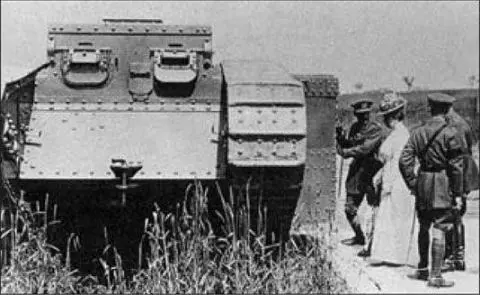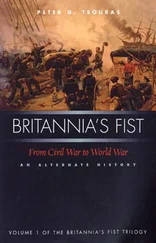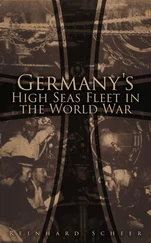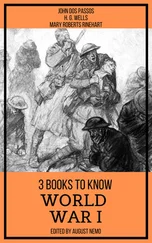In capturing the village of Hamel itself, the 44th Battalion found strongly garrisoned trenches on the ridge beyond the village, from which the Germans were bringing down heavy machine-gun fire. The infantry called for help from their tanks. The right flank of the 44th was fired on from what turned out to be a German battalion headquarters. A tank officer was ‘walking about’ and, as soon as he was contacted, he directed his tank towards the enemy, who immediately stopped firing and bolted. The tanks then moved up and down the trench, from which the infantry captured fifty prisoners and twenty-seven machine-guns.

A supply tank being demonstrated to Queen Mary, July 1917. These tanks were used to ferry supplies forward to help the infantry consolidate on an objective, and thus preserve their energy for combat duty (Tank Museum image).
Once the final objectives had been taken, there was prompt action to consolidate the newly won positions. Another great advantage of the Tank Corps now became apparent. Four carrier/supply tanks delivered supplies that would have required the use of more than 1,200 men, and did so immediately to a position just behind the new front line. 25
The infantry either occupied the old German trenches or dug new ones. This was achieved quickly with the assistance of the tanks, which now helped the digging infantry by destroying opposition that threatened to interfere with the digging.
Valuable as the tanks proved to be, however, their role has often been exaggerated in the later accounts of the Tank Corps historians:
The whole day was to be one long triumph for the new Mark V tank. The new tanks were possessed, the Germans found, of a deadly power on manoeuvre which they used to the full, expending little ammunition upon machine-gun nests, but, even when they had passed an emplacement in the first rush, swinging swiftly round on the wretched gunners and crushing guns and crews beneath their tracks. This method, they said, eliminated all chance of the enemy coming to life again after the attack had passed by. 26
Conversely, tank historian Williams-Ellis also acknowledges the primary role of the infantry, commenting on the cooperation between the two arms:
But at first the most striking characteristic of the victory seemed the perfect co-operation between the tanks and the infantry. The tanks and the Australians were equally enthusiastic over one another’s performances. The Australians were surprised and delighted at the weight and solidity which the sixty tanks had lent their impact, and at the sense of support and comradeship which their men had experienced.
The tanks were equally impressed by the superb morale of the Australians, who never considered that the presence of tanks exonerated them from fighting, and who took instant advantage of any opportunity created by the tanks.
A generous and lasting friendship had been established. The 5 thTank Brigade and their Australians were destined throughout their coming partnership to be an almost invincible combination. 27
Perhaps Williams-Ellis goes a little far in his final comment on the newfound friendships that followed the Battle of Hamel: ‘The 5 thTank Brigade and the Australians had sworn eternal friendship with a refreshing enthusiasm. They were like two schoolgirl friends, not to be separated, and at Vaux-en-Amienois, whither they had retired for combined training, metaphorically went about all day with their arms about each other’s waists.’ 28
While Bean was not so effusive in his commentary, he was nonetheless very positive:
Hitherto it had been a definite disadvantage to the Tank Corps that since Bullecourt the Australians had distrusted the tanks, and to a certain extent their crews. Comments from infantry commanders after the victory of Hamel included such statements as: ‘The tank saved us a great number of casualties at the final objective. It gave an ideal illustration of co-operation with infantry.’ [and] ‘I feel sure that tanks, when so ably used, could obviate the need for a final protective barrage and leave more scope for exploiting success. The tanks even appeared to anticipate the infantry’s desires.’ [and finally] ‘Having seen them in action the infantry have a very high opinion of their work.’ 29
One of the most interesting accounts of the battle is that contained in a letter from an Australian soldier, Private Sydney Huntingdon, to his wife. 30Huntingdon was a member of the 7th Company of the 2nd Australian Machine Gun Brigade. On 3 and 4 July, his company was on the hillside north of the Somme which allowed him a clear view of the action unfolding in front of him:
It was on the fourth of July that we started to hop over◦— you must remember that all this time we lay on the hillside waiting for the word to start. Most of the night we lay on the hillside absorbed in these things. It was one of the quietest we had ever seen on the front. Now and then a machine gun chattered a few halting sentences. Once or twice our guns carried out their nightly strafes on to some sensitive point behind the German lines.
At three o’clock when the sky way greying towards dawn, there broke out into the normal dawn bombardments a terrible strafe of a thousand shells from the enemy guns. Some minutes later our guns answered shot for shot and reflected upon the skyline and hillsides opposite what one American soldier described to us that morning as ‘some firework’.
In the waves of infantry which went over behind that barrage there were several companies of Americans◦— the first to enter any action on the British front. They had never been under fire before this position opened just ahead of them. They were at that moment moving towards it amongst the Australian infantry & the tanks, although of course we could not see them, nor they us at any distance.
Later in the day we were surprised to see higher slopes behind Hamel further back than this one. But at this moment there was only one gentle hill beyond Hamel, and then the even grey sky. It was the very moment when our men should be nearing that hill-top. Moving along the top of it was a low grey monster. It was like a knob on the nose of the hill — a pimple◦— a wart. It moved slowly along the crest sideways, like some legless insect◦— perhaps a woodlouse would be the best resemblance. There was another & another to right & left of it, and crowds of infantry between them. They were moving up towards that skyline along its whole length.
Some figures go up from the cornfield at its side, walk away a few yards, and then started to run & we lost sight of them. I think they must have been Germans. Now there was a sunken road leading up to the wood of Accroche. We looked straight up it at the wood. We fancied earlier that we saw a few men at the top end this road but now there was a tank at the bottom of it, and the road was empty. Not a sign of movement in the whole length of it, only the dark shadow spots which showed the entrances of small dugouts or shelters in the banks of it. The tank moved up it to the top and lay there for a moment with her nose turned in to the bank.
We thought that she had stuck there, but the next time we looked she had climbed on to the bank and was there seated on the top of it. Much later in the day we heard that as she went up the road, she found that there were Germans sniping from one of those dugouts which the infantry had passed. She climbed the opposite bank and fired her small gun straight in at the entrance.
We had not watched this tank continuously, for at this moment other tanks and the infantry around them had appeared at both the northern & southern corners of Accroche wood. We could see the men at the northern end very clearly in groups a little this side of the wood, clearly choosing their position for digging in.
Читать дальше













